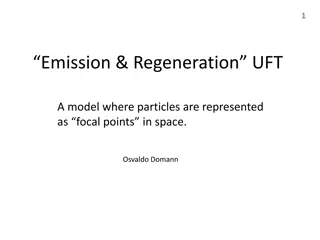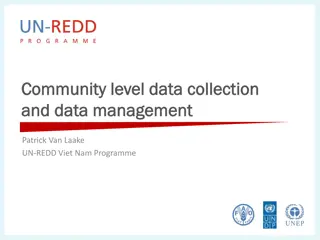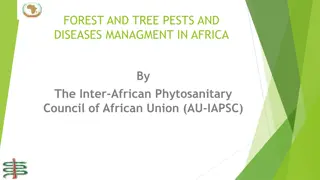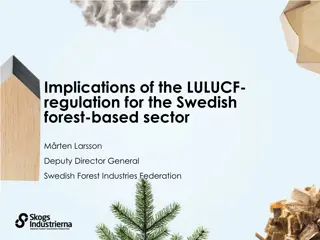Hawai'i Forest Industry Association (HFIA)
HFIA is a statewide, nonprofit trade association established in 1989. Our mission is to promote healthy and productive forests and a sustainable forest industry through forest management, education, planning, information exchange, and advocacy.
1 views • 8 slides
Exploring Different Ecosystem Types and Functions
Learn about the major types of ecosystems such as Grassland, Aquatic, Forest, and Desert presented by Priyanka Chowksey of DAIMSR. Understand the components of an ecosystem, including biotic and abiotic factors, and the significance of different ecosystems like Forest Ecosystem and Desert Ecosystem.
4 views • 29 slides
Tamil Nadu Forest Uniformed Service Recruitment Committee (TNFUSRC)
Tamil Nadu Forest Uniformed Service Recruitment Committee (TNFUSRC)\nThe Tamil Nadu Forest Uniformed Services Recruitment Committee (TNFUSRC) is an organization responsible for recruiting candidates for various uniformed services positions within the Tamil Nadu Forest Department.\nSelection process
0 views • 5 slides
California Forest Improvement Program (CFIP) Overview
The California Forest Improvement Program (CFIP) aims to promote investments in forestlands to ensure timber supplies, employment, and economic benefits while enhancing the forest resource. Funding sources, program objectives, eligibility requirements, and reimbursement details are covered in the pr
1 views • 22 slides
Prestige Forest Hills | Best Residential Homes In Mumbai
Prestige Forest Hills is a luxury residential property located in Bangalore. It offers 2\/3\/4 BHK apartments, every house exudes beauty and comfort. Residents can enjoy many luxury facilities consisting of landscaped gardens, a clubhouse, a swimming pool, and leisure centres. It ensures access to t
6 views • 11 slides
Understanding Forest Fires and Their Causes in India
Forest fires have become increasingly common in India, with recent incidents in various states causing significant damage to biodiversity and ecology. Factors such as smoking, campfires, fireworks, burning debris, and natural causes like lightning contribute to the occurrence of these devastating fi
0 views • 13 slides
Principles of Advanced Forest Management
Explore sustainable forest management theories, inventory methods, yield regulation approaches, and project planning for effective decision-making in forest resource management. Delve into the principles of forest management, land classification, growth projection, yield prediction, and sustainable
0 views • 26 slides
Realistic Particle Representations and Interactions in Emission & Regeneration UFT
The presentation explores a model in which particles are depicted as focal points in space, proposed by Osvaldo Domann. It delves into theoretical particle representations, motivation for a new approach, and the methodology behind the Postulated model. Additionally, it delves into particle represent
1 views • 24 slides
Framework for Building National Forest Monitoring Systems for REDD+
This module outlines a comprehensive framework for developing national forest monitoring systems for REDD+ initiatives. It covers key components such as satellite land monitoring, national forest inventories, greenhouse gas reporting, emission factors, and integrated monitoring systems focusing on c
0 views • 14 slides
Community-Based Data Collection and Forest Management for REDD+ Initiatives
Participatory approaches in forest management by local communities have shown success in conservation efforts. Ownership, long-term commitment, and social pressures play key roles. Additionally, secondary uses of the forest, carbon assessment by communities, supplementary data collection, and effici
0 views • 12 slides
The Legend of Sherwood Forest: From Royal Hunting Reserve to Nature Reserve
Sherwood Forest, once a royal hunting reserve in the 10th Century, is renowned for its association with the legendary figure Robin Hood. The forest provided cover for both hunting and outlaws, eventually becoming a nature reserve attracting millions of visitors annually. Despite its reduced size fro
0 views • 9 slides
Overview of Forest Resources in Finland
Forest resources in Finland consist of various types of land, with forest land being the most dominant at 67%. Pine and spruce are the most common tree species, making up 80% of the total volume. Private forest owners own a significant portion of forest land at 60%. The growth of Finnish forests is
2 views • 6 slides
Forest Resources and Challenges in India: A Detailed Overview
India's forest resources face challenges due to degradation, impacting the economy and environment. The country produces a range of forest products, with forestry contributing to GDP. However, unsustainable practices such as excessive fuelwood consumption pose threats. Non-wood forest products are s
0 views • 48 slides
Forest Management Recommendations and Studies Overview
The content discusses various aspects related to forest management, including conversion summaries, FRPA stocking standards, existing data evaluations, and recommendations for future studies. It emphasizes the need for systematic reviews, research on regeneration processes, and gathering more inform
0 views • 6 slides
Conservation Efforts and Threats to Biodiversity at Nolde Forest
Nolde Forest State Park, established by hosiery baron Jacob Nolde in the early 1900s, is a lush coniferous forest now dedicated to environmental education. The park faces threats to biodiversity such as natural disasters, invasive species, and human activity. Hurricane Sandy's impact in 2012 and the
2 views • 13 slides
Power of Regeneration in Nature and Beyond
Explore the fascinating world of regeneration as seen in different organisms such as sea sponges, plants like rose bushes, earthworms, starfish, salamanders, and even mammals like rabbits and humans. Discover the remarkable ability of these creatures to regenerate and recover from injuries, highligh
0 views • 15 slides
Sustainable Forest Management for Carbon Conservation and Biodiversity Enhancement
Sustainable forest management practices focused on conservation and enhancement of forest carbon stocks, reduction of deforestation and degradation, rural electrification, and improvement of forest management unit plans. Initiatives include assessment of forest resources, capacity building for field
1 views • 4 slides
Białowieża Forest: Europe's Last Primeval Forest
Białowieża Forest, the largest natural forest complex in the Central European Lowlands, is a treasure trove of diverse forest communities and abundant wildlife. Protected since ancient times, it faces threats like the European spruce bark beetle. Ecologists advocate for forest conservation to pres
0 views • 13 slides
Overview of The Levelling Up and Regeneration Bill
The bill covers provisions for levelling-up missions, local democracy, town planning, Community Infrastructure Levy, regeneration, compulsory land purchases, and governance of institutions. Additionally, it introduces a new Capital Risk Monitoring regime focusing on debt, asset investments, and coun
0 views • 5 slides
Planarian Regeneration in Microgravity Experiment at Kent Place School
Investigating how a microgravity environment impacts cellular regeneration in Dugesia Tigrina planarians. The study aims to understand if wounds can heal in space and provide insights into the regeneration process without risking human health. By studying the similarities between human and planarian
0 views • 9 slides
Understanding Deer Impact on Forest Regeneration
Explore the collaborative deer management outreach initiative focused on maintaining healthy forests by addressing the impact of white-tailed deer on forest regeneration. Learn about the factors influencing forest health, predicted regeneration of tree species, and survey results on forest regenerat
0 views • 27 slides
Understanding Tissue Repair Mechanisms: Regeneration and Fibrosis
Tissue repair involves complex mechanisms like regeneration by parenchymal cells or fibrosis leading to scar formation. Inflammatory cells play a crucial role in tissue repair, along with processes like ECM synthesis and cell migration. Different types of cells in the body have varying regenerative
0 views • 20 slides
Tissue Regeneration, Repair, and Inflammation Explained
Tissue regeneration and repair processes involve either regeneration of cells or connective tissue repair, depending on the type of cells injured. In cases where regeneration is not possible, healing occurs through the formation of scar tissue. The healing process aims to restore the structural cont
0 views • 40 slides
Understanding Tissue Repair: Regeneration and Fibrosis Mechanisms
Tissue repair involves two primary mechanisms: regeneration, where some tissues can replace damaged cells, and fibrosis, where scar tissue forms if regeneration is not possible. Cell proliferation, growth factors, and cell population control play key roles in the restoration of tissue architecture a
0 views • 15 slides
Understanding Wound Healing Processes
The body's response to injury involves two main processes of wound healing - regeneration and repair. Regeneration involves proliferation of parenchymatous cells, while repair results in fibrosis and scarring by proliferation of connective tissue. Different types of cells play varying roles in the h
0 views • 12 slides
Roundtable on Urban Regeneration: Social Value Creation with Diverse Speakers
The Roundtable on Urban Regeneration focuses on challenges posed by Covid-19, Climate, and Conflicts on inequalities. It explores how urban regeneration can address these challenges and create social value while reducing poverty and inequality. The event also delves into the role of the private sect
0 views • 15 slides
Reforming State-Owned Forest Enterprises and Ensuring Ethnic Minority Land Tenure Security in Vietnam
Vietnamese government nationalized agricultural and forest land in the 1950s, impacting ethnic minority groups. Despite attempts to reform state-owned forest enterprises, conflicts over forest land persist. This study examines policies, processes, and conflicts in three provinces to offer recommenda
0 views • 20 slides
Understanding REDD+ and Forest Governance for Sustainable Resource Management
REDD+ stands for Reducing Emissions from Deforestation and forest Degradation, encompassing activities to enhance carbon stocks, conservation, and sustainable forest management. Forest governance plays a crucial role in reducing risks related to land use change, illegal logging, and forest degradati
0 views • 11 slides
Forest and Tree Pests and Diseases Management in Africa
The management of forest pests and diseases in Africa is crucial to safeguard the continent's forests, international trade, and forest products. This presentation provides insights into the occurrence, distribution, economic impacts, and regional cooperation for managing forest pests. Major pests an
0 views • 12 slides
Jerome Smith - Forest Department Director Promoting Bioeconomy in Mountain Areas
Jerome Smith is the Principal Director of Forest Operations in Jamaica, focusing on environmental policies and sustainable forest management. He has spearheaded various programs, including the EU-supported initiative to address climate change challenges through improved forest management in Jamaica.
0 views • 8 slides
Optimal Sustainable Control of Forest Sector with Stochastic Dynamic Programming and Markov Chains
Stochastic dynamic programming with Markov chains is used for optimal control of the forest sector, focusing on continuous cover forestry. This approach optimizes forest industry production, harvest levels, and logistic solutions based on market conditions. The method involves solving quadratic prog
0 views • 27 slides
Assessing Forest Loss in Protected Areas: A Philippines Case Study
The study assesses forest cover loss in terrestrial protected areas of the Philippines, analyzing the extent and rate of deforestation using Hansen's Global Forest Cover Change datasets. The research aims to understand the drivers of deforestation in protected areas, comparing forest loss in the ent
0 views • 24 slides
Understanding the Calvin Cycle in Photosynthesis
The Calvin Cycle is a crucial part of photosynthesis where sugar is synthesized from smaller molecules using ATP and NADPH. It involves three phases: Carbon fixation, Reduction, and Regeneration of the CO2 acceptor. Steps include Carbon Fixation, Reduction, and Regeneration of RuBP. The cycle ultima
0 views • 9 slides
Understanding Calcium Influence on Earthworm Behavior in Forest Ecosystems
Earthworm biomass dominance by Lumbricus terrestris in the Siemianice Experimental Forest is linked to their high calcium requirements, as indicated by their calciferous glands producing calcium carbonate to regulate blood pH in the face of high soil CO2 levels. The positive relationship between for
0 views • 8 slides
GEF Forest Investments and Sustainability Strategies
The Global Environment Facility (GEF) focuses on financing forest projects to address climate change, biodiversity conservation, and land degradation. With a history of investing in forests since 1991, GEF has created programs like GEF-5 SFM/REDD-plus to generate multiple environmental and social be
0 views • 11 slides
Monitoring Forest Cover Disturbances During Natural Hazards by Meteorological Satellites
Ecosystem functioning relies on energy, water, and carbon fluxes regulated by vegetation and soil properties. This study focuses on monitoring forest cover disturbances before, during, and after natural hazards using meteorological satellites. It involves analyzing land surface temperature, evapotra
0 views • 37 slides
Understanding Forest Classification and Management
Explore the classification of forests based on age, regeneration, composition, management objectives, and ownership. Learn about even-aged and uneven-aged forests, natural vs. man-made forests, pure vs. mixed forests, and protection, production, and social forests. Discover the various factors that
0 views • 10 slides
Implications of LULUCF Regulation for Swedish Forest Sector
The Swedish Forest Industries Federation discusses the implications of LULUCF regulation on the forest-based sector in Sweden, aiming for a fossil-free welfare state by 2045. The sector plays a vital role in driving growth in the global bioeconomy, with sustainable forest management strategies highl
0 views • 14 slides
Empowering Communities Through Micro Planning for Forest Development
Micro Planning is a community-based process empowering forest-dependent communities to create a roadmap for sustainable development. Joint Forest Management Committees and other bodies organize the preparation of ten-year development plans prioritizing activities for enhanced livelihoods. The proces
0 views • 15 slides
Safeguarding Indigenous Peoples and Forest Communities in REDD+
Exploring traditional forest knowledge and its importance to culture, livelihoods, and conservation efforts. The IUFRO Task Force focuses on preserving traditional knowledge, addressing threats, and identifying opportunities for collaboration with modern forest science. Unique features include susta
0 views • 10 slides







































